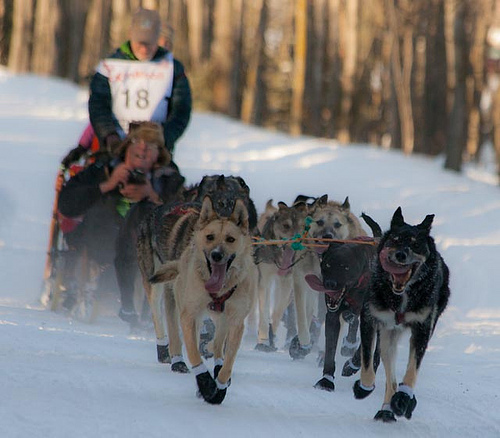The Last Great Race on Earth: Iditarod 2014
Back To Blog
This photo is used under a Creative Commons license by Alaskan Dude.
Historically, dog mushing was used as a form of local transportation for day-to-day supplies, mail and travel. In 1925, dog sledding became crucial in saving the lives of hundreds of children when the community of Nome was plagued with diphtheria. The medication was located in Anchorage; and, with a blizzard taking over Western Alaska, the only form of transportation available was dog sleds. A tag team of 20 mushers and their dog sled teams endured the journey to Nome in late January, arriving in Nome six days later on Feb. 2, 1925, and consequently saving hundreds of lives. After snowmachines came to Alaska, dog mushing became a recreational activity for most, rather than a vital means of transportation.
The Iditarod was originally introduced as a 56-mile race from Knik to Big Lake and back. After two short races in 1967 and 1969, the race was reintroduced in 1973 as a much longer, grueling competition from Anchorage to Nome. Following a ceremonial start, the first mile and a half are on Anchorage city streets with hundreds of fans on each side to watch the beginning of Alaska’s best known sporting event.
The Iditarod Trail ventures both south and north depending on the year the race takes place. On the even years, the trail goes north with 26 checkpoints and on the odd years the trail goes south with 27 checkpoints. The reasoning for the two different trails is so that a variety of villages have the opportunity to experience the thrill of having the sled dog teams go through their community.
Each musher has a team of 12 to 16 dogs traveling over 1,100 miles through extreme climates and treacherous trails. The temperatures can reach anywhere from 40 above to 100 degrees below zero. The mushers and their teams have to endure snow, ice and wind. The mushers must be weary of frostbite, water overflow and blizzards for the safety of their four-legged companions and themselves. In 1991, the blizzard on the trail was so treacherous that musher Rick Swenson tied himself to his dogs and snow shoed through the blizzard on the final stretch to Nome. Wildlife in Alaska can also be a large threat to dog sled teams. Moose have been known to charge sled dogs and even the mushers along the trail.
The Iditarod generally takes a musher and his or her team nine to 17 days to complete. Even with a great differential between the first and last team to cross the finish line, there have been some close finishes in the past. In 1978, Dick Mackey’s dog’s nose won the race for him, being the first team to win the race without being the first sled to cross the finish line. Teams are greeted at the finish line in Nome by hundreds of spectators from all over the world who have traveled to see the end of this amazing race.
The winners are granted many different awards and prizes. The last musher to glide over the finish line also receives a prize of a red lantern. Though it started off as a humorous joke, the red lantern has become one of Alaska’s great traditions. And, regardless of where they place, each musher who crosses the finish line after days in Alaska’s harsh backcountry in winter deserves recognition as a winner.